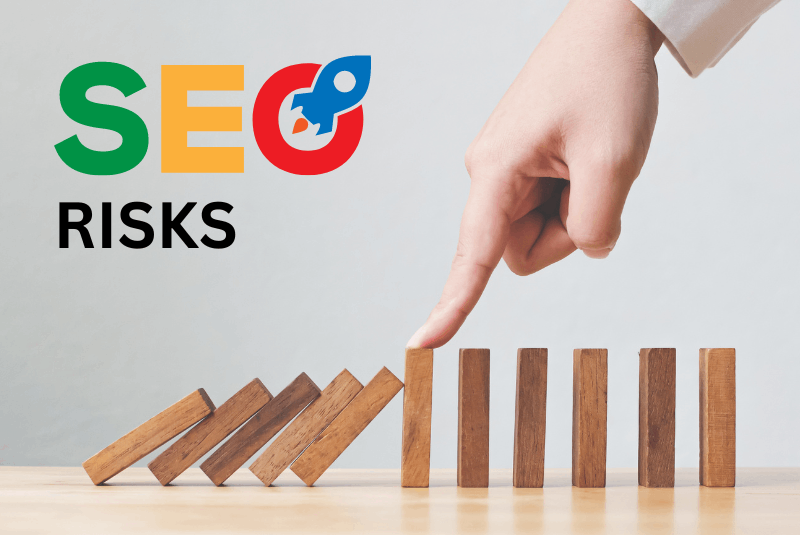Search Engine Optimization (SEO) is a broad and ever-changing topic for increasing traffic to websites and social media platforms. Applying SEO techniques need a high amount of information, and therefore many businesses have a hard time getting results from those techniques.
An effective SEO strategy may take months to give positive results on the site, and the tactics generally don’t make sense to the optimizers, but both strategy and tactics can show significant improvement to the online platforms and ultimately leading to higher profits.
Nearly every business decision carries risk in itself. Similarly, taking risks in Search Engine Optimization can lead to a drastic growth of traffic in a short period. Not all risks are worth considering as it may lead to a downfall in the numbers.
The question that stays here is which risks in SEO are worth it, and which should be avoided. Let us consider some of those risks here.
Worth Taking SEO Risks
Making large and small changes with testing
The overall goal of doing SEO is to get traffic and, ultimately to get higher profits. This can’t take place if nobody clicks on your website. Sometimes, you don’t get ranked well, even though you use specific keywords.
The only way to do changes is through A/B testing. Take one element at a time. Whether its meta descriptions, titles or the content and test them against new variations.
Getting & Giving High-quality backlinks
Backlinks are a well-established part of SEO where you want to get as many of them as they can. Quality Backlinks help increase rankings and build authority.
However getting quality backlinks is not everyone’s piece of cake. It takes a little giving to gain something. You may lose some visitors by providing a link to high-quality sites, but it shows to Google that you are using reliable sites with higher authority.
Improving the site’s URL structure
Ideally, the URL of the homepage must be short, with only enterprise’s name in it. It should be short, simple and easily remembered. Other pages should have keywords that are targeted and need to be more specific about the contents of the webpage.
The risk here is that any change to the URLs can impact your rankings. As you alter URLs and put ‘301 redirect’ to the new ones, you may notice some drops in your site rankings.
Overhauling of a website
Websites must be updated and redesigned every once in a while as new designs keep surfacing the internet. However, redesigning can be risky, time-consuming and expensive.
If your website looks extremely outdated, it may need a new facelift. There can be many reasons such as unattractive graphics, difficulty in navigating through the site and many more. Consider reconstructing a site with proper and attractive graphics, systematic sitemap and robot.txt file.
Buy Expired or Available Domains
Buying some domains with history and redirecting them to your site is a quicker way to increase the number of valuable backlinks to your site. These backlinks help you add the link juice to your site. This technique can drive some good traffic if you follow the right practices.
There are some serious risks relating to this technique. For example, only buy a domain that is related to your business. It should be professional and relevant to some authority because if that domain receives traffic, those visitors will be redirected to your site.
If your site is irrelevantly back-linked with that domain, then it may seem frustrating to the visitors who wanted the answer to the query of their original search. Never buy domains that are loaded with spammy links and content.
SEO Risks to Avoid
Poor Doorway Pages (Or Not at all!)
Doorway pages are the ones that are easy to create and target specific keywords or keyword groups on the whole page. Authentic SEO doers avoid doorway pages because Google’s algorithm dislikes them and penalizes the sites that use them.
The only way Google allows doorway pages to slide in is if they offer unique, relevant and valuable content to the visitor.
Disallowing Neutral Backlinks
Neutral backlinks are the ones that don’t attract much traffic to your site, but they also won’t subject your site to Google’s penalties. The only way to know if the backlinks are spammy or low-quality ones is if Google takes any manual action on your site.
If no action is taken, your site may seem safe. But there may be links that are not effectively boosting your site’s search rankings. Use the Disavow tool to remove specific backlinks but remain sure that you’re not blocking sites that could improve your ranking.
Using Exact Match Keywords in Anchor text
It seems logical to use the target keyword as the anchor text for a link to your website since you want your site to rank for that keyword or phrase. This technique was highly popular among the SEOers in the past. But it got heavily abused by “Black Hat” Optimizers who used the exact match keyword excessively to link to their websites.
Google in its update has rectified this bad practice and heavily penalized the websites that overdo this practice. Don’t risk to practice this technique. Look for systematic ways to link your site.
Conclusion
Due to advancements in Digital Marketing, Search Engine Optimization is essential for the success of any business. Although there are many risks in SEO techniques, some of the risks are worth taking because they give positive results for your business.
Involving other risks can significantly harm the brand name and hurt the online presence of a business. Not taking any risks in SEO is only thing riskier than taking some.

